 Zusammenfassungen
Zusammenfassungen
 The idea that human history is approaching a "singularity" -- that ordinary humans will someday be overtaken by artificially intelligent machines or cognitively enhanced biological intelligence, or both -- has moved from the realm of science fiction to serious debate. Some singularity theorists predict that if the field of artificial intelligence (AI) continues to develop at its current dizzying rate, the singularity could come about in the middle of the present century. Murray Shanahan offers an introduction to the idea of the singularity and considers the ramifications of such a potentially seismic event.
The idea that human history is approaching a "singularity" -- that ordinary humans will someday be overtaken by artificially intelligent machines or cognitively enhanced biological intelligence, or both -- has moved from the realm of science fiction to serious debate. Some singularity theorists predict that if the field of artificial intelligence (AI) continues to develop at its current dizzying rate, the singularity could come about in the middle of the present century. Murray Shanahan offers an introduction to the idea of the singularity and considers the ramifications of such a potentially seismic event.
Shanahan's aim is not to make predictions but rather to investigate a range of scenarios. Whether we believe that singularity is near or far, likely or impossible, apocalypse or utopia, the very idea raises crucial philosophical and pragmatic questions, forcing us to think seriously about what we want as a species.
Shanahan describes technological advances in AI, both biologically inspired and engineered from scratch. Once human-level AI -- theoretically possible, but difficult to accomplish -- has been achieved, he explains, the transition to superintelligent AI could be very rapid. Shanahan considers what the existence of superintelligent machines could mean for such matters as personhood, responsibility, rights, and identity. Some superhuman AI agents might be created to benefit humankind; some might go rogue. (Is Siri the template, or HAL?) The singularity presents both an existential threat to humanity and an existential opportunity for humanity to transcend ist limitations. Shanahan makes it clear that we need to imagine both possibilities if we want to bring about the better outcome.
 Dieses Buch erwähnt ...
Dieses Buch erwähnt ...
 Personen KB IB clear | James Barrat , Erik Brynjolfsson , Stanley Kubrick , Ray Kurzweil , Jaron Lanier , Andrew McAfee , Gordon Moore , Alan Turing | ||||||||||||||||||||||||||||||||||||||||||||||||||||||||||||||||||||||||||||||||||||||||||
 Begriffe KB IB clear |  Künstliche Intelligenz (KI / AI) Künstliche Intelligenz (KI / AI) artificial intelligence
, artificial intelligence
,  paperclip maximizer
, singularity pointsingularity point
, stuxnet
, paperclip maximizer
, singularity pointsingularity point
, stuxnet
,  Synthetische Biologie
, Wearable ComputingWearable Computing Synthetische Biologie
, Wearable ComputingWearable Computing
| ||||||||||||||||||||||||||||||||||||||||||||||||||||||||||||||||||||||||||||||||||||||||||
 Bücher |
| ||||||||||||||||||||||||||||||||||||||||||||||||||||||||||||||||||||||||||||||||||||||||||
 Texte |
|
 Zitationsgraph
Zitationsgraph
 Zitationsgraph (Beta-Test mit vis.js)
Zitationsgraph (Beta-Test mit vis.js)
 Zeitleiste
Zeitleiste
 4 Erwähnungen
4 Erwähnungen 
- Being you - A new Science of Consciousness (Anil Seth)


- AI Ethics (Mark Coeckelbergh) (2020)

- Mensch, Maschine, Identität - Ethik der Künstlichen Intelligenz (Orlando Budelacci) (2022)


- The Future of AI in Education - 13 Things We Can Do to Minimize the Damage (Arran Hamilton, Dylan Wiliam, John Hattie) (2023)


 Co-zitierte Bücher
Co-zitierte Bücher

Flow
Das Geheimnis des Glücks
Flow
The Psychology of Optimal Experience
(Mihaly Csikszentmihalyi) (1990)
Mind Children
(Hans Moravec) Volltext dieses Dokuments
Volltext dieses Dokuments
 Bibliographisches
Bibliographisches 
 Beat und dieses Buch
Beat und dieses Buch
Beat hat dieses Buch während seiner Zeit am Institut für Medien und Schule (IMS) ins Biblionetz aufgenommen. Beat besitzt kein physisches, aber ein digitales Exemplar. (das er aber aus Urheberrechtsgründen nicht einfach weitergeben darf). Es gibt bisher nur wenige Objekte im Biblionetz, die dieses Werk zitieren.









 (
(














 , 1833 kByte)
, 1833 kByte) 



 Biblionetz-History
Biblionetz-History